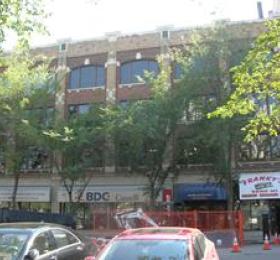MacMillan Building
- Holding Bylaw
Description of the Historic Place
The MacMillan Building is a four storey commercial office building that exhibits characteristics of the Chicago style. Constructed in 1926, the MacMillan Building is considered to be an architectural gem in the city’s downtown.
This historic place, located at 135 21st St East, is listed under Bylaw No. 6770 (Holding Bylaw). This Bylaw provides short-term protection of the building from demolition by providing for a 60 day holding period in the event a demolition permit is received. Within that 60 day period heritage designation is considered by City Council.
Heritage Value
The MacMillan Building exhibits characteristics of the Chicago style of architecture, which flourished from the late 1890s to the 1930s. Chicago style buildings were usually decorated in sculpted stone or terracotta, as found on the original masonry for the MacMillan Building. The office building was designed by architect Frank P. Martin, and also features a grid like organization of windows, a façade divided into three separate zones including a massive lower storey with prominent display windows, and an attic storey with sharp cornices.
In addition to its architecture, the heritage value of the MacMillan Building resides in its association with one of Saskatoon’s most influential citizens during the formative years of the city - Chicago born Frank R. MacMillan. MacMillan, who settled in Saskatoon in 1909, was an early Saskatoon merchant, alderman, mayor, and Member of Parliament. In 1921, MacMillan acquired the Drinkle No. 1 block, and later constructed the MacMillan Building on that site when the existing structure was destroyed in a fire in 1925.
MacMillan was alderman for six years (1913-1919) and briefly served as mayor from 1919 – 1920. His political ambitions extended to the national level when he won his own seat as Conservative Member in the House of Commons in 1930. During the Depression, he helped to attract many relief projects to his constituency. These projects included the construction of Saskatoon's Broadway Bridge, the 19th Street Subway, and the CP Bridge in Lumsden. He returned to Saskatoon in 1935 and, at various times, served as President of the National Parks Association, Saskatoon's Board of Trade, the Boy Scouts, the Red Cross, the local Navy League and the Racing Committee of the Saskatoon Exhibition.
Ownership of the MacMillan building remained within the MacMillan family company up until 1976.
Source: City of Saskatoon Built Heritage Database
Character Defining Elements
Key elements which contribute to the heritage value of this historic resource include:
- Its architectural style, with Chicago influences, evident in: its masonry cladding; its separation of the base, middle and top columns through the use of materials (buff brick, Tyndall stone and terracotta) and ornamental detail; grid like organization of windows, a façade divided into three separate zones including a massive lower storey with prominent display windows, and an attic storey with sharp cornices;
- Its parapet roofline, stepped above the wall pilasters;
- Its cornice and frieze of Tyndall stone that defines the top of the main level; and
- Those features that represent the buildings historical significance, such as its form, scale and massing and its original location.

